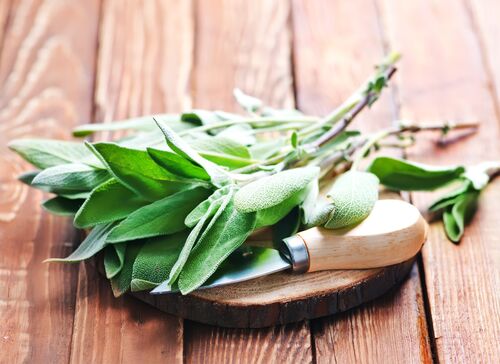Growing and Sowing Sage

Sage is a perennial herb and is native to the Mediterranean regions. This herb is not only used in the kitchen. Sage is also known for its medicinal properties, it has an anti-infective and anti-inflammatory effect.
Sage in the vegetable garden
Sage fits in every vegetable garden. It is a beautiful plant that gets pretty flowers later in the year. Sage grows best in full sun and the sun adds an extra tasty flavor to the leaves. The leaves of non-flowering shoots are the tastiest. It is not a hardy plant, but they can hibernate by moving it indoors in time.
When to sow sage
You can sow sage in the spring from the end of April outdoors or a little earlier if you start sowing the sage seeds indoors or in a greenhouse. Make sure that the soil is well aired because sage does not like wet feet. You can add some sand when you sow directly outside if the soil is hard and dry to keep things a bit more airy.
How to sow sage
Sowing sage is easy, just like almost all types of herb seeds. Place a number of seeds in pots and water them daily. Preferably with a plant sprayer. This is because the soil should be moist but not soaking wet. The sage seeds certainly do not need to be sown deeply. Covering it with a thin layer of sand. The advice is to grow the seeds in pots of 4x4cm or 6x6cm, so they can grow in that pot a little longer before planting them out. The germination process takes about 2 to 3 weeks. When the plants are a few centimeters high (or 5 to 10 cm), they can be planted out in their final spot. Keep in mind that the plant grows to about 50 cm wide and up to 70 cm high, so leaving some space between the plants is recommended>
Where to sow sage
Sage loves warmth so a nice spot in the sun would be fantastic for the sage plant.
Sage seeds
To get the best results from sage seeds, it is recommended to use fresh sage seeds. Sage seeds usually keep for a number of years, as long as they are kept dry and not too warm. In the webshop of Dutch Garden Seeds we have 2 types of sage seeds: regular sage seeds and organic sage seeds.
Sage cuttings
It is easy to propagate sage. You cut a piece of a fresh stem at an angle in the soft green part.
- Remove the lower leaves to get a new stem to put in the ground.
- Put the stem in a pot with a mixture of potting compost and sand to aerate the soil.
- Place in a shaded spot and water regularly. Your new Sage plant will grow slowly.
Can you freeze sage?
The best tip we can give is actually to freeze the sage leaves in an ice cube tray by placing the amount you use per dish in the tray, then add water and freeze it. If you want to use the sage in a dish you can easily add a sage ice cube. This way the taste of the sage will be still preserved.
How Drying sage
It is also possible to dry the sage.
There are at least 3 ways to dry the sage.
- In an oven: Wash the sage and place on a clean baking sheet. Set the oven to 40°. Then leave it in for 1 to 2 hours. Check it regularly. After the sage has become crispy, you can let it cool down and put it in an airtight glass jar. NB! after about half a year, the taste will diminish.
- In a food dryer: basically the same description as above, only for 12 hours, around 35 degrees.
- Dry sage by hanging: Wash the sage and bundle it. You can put the bundles upside down in a paper bag and hang them up. Make some small cuts in the bag to allow the air to flow through. Let the sage hang for about 2 weeks. Check to see if the sage is dry enough to put in a jar.
Growing herbs
Growing herbs is a healthy activity. Besides the fact you are actively involved, it is also wonderful to always have fresh herbs around. Almost all herbs have a medicinal effect and health benefits. In the webshop of Dutch Garden Seeds we have more than 40 different types of herb seeds. Of these, there are about 15 Organic herbal seeds.



